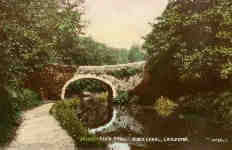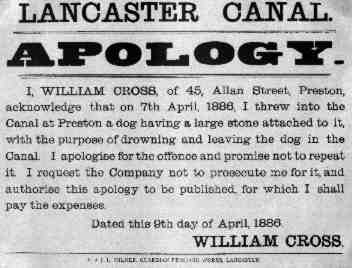![]()
Meanwhile, in 1837 an agreement had been made to lease, in perpetuity, the tram road to the Bolton and Preston Railway Company, thus the railway received all of the tolls from the freight on the southern end, except those from the Leeds and Liverpool Canal. In exchange, the railway agreed to pay the canal company a rental of £8,000 per annum, and build a short transfer siding from their Preston terminus to the canal basin - one engine being reserved exclusively for use on transferred traffic.
With further expansion of the railways, the tram route became surplus, but the canal company insisted on the railway keeping it, although there was an agreement on some reductions in the rental amount.

Right: Broken Back Bridge, near Lancaster, apparently so-named because of the curved parapet wall
In 1836 the Ribble Pumping Station was sold off as it was no longer required for water supply, and in June, 1840, the railway to Lancaster was opened. Because of problems with the construction of the railway tunnels and cuttings, and reduced traffic levels, the Lancaster and Preston Junction Railway found itself in severe financial difficulties, and the canal company took advantage of the position and purchased a 21 year lease on the railway, which it operated successfully, until a fatal accident at Bay Horse, in 1848, caused the canal company to be forced into giving up its railway operation.
Increased competition for freight carriage from the railways caused the canal company to seek new traffic, and new vessels on the canal included the steamer, Duchess, and several steam tugs. Many of the coastal vessels were lost at sea or in the estuaries, and trade gradually dropped away.
Life on the canal did not always go according to plan, with the navigation being obstructed at various times by leaks and breaches, which resulted in a section of canal being closed and drained for repairs. The Kendal to Tewitfield section suffered many leaks due to the nature of the limestone rock over which the canal bed passes. Major problem areas were at Natland and Burton, which had persistently recurring leaks over many years - those at Natland finally being the cause of the abandonment of the most northerly two miles.

Breaches were a very serious problem - when the canal banking gave way millions of gallons of water were lost to the canal, and if the breach was in a populated area, such as that at Preston in the 1800's, lives could have been at risk.

Repairs to the canal were carried out, until quite recently, by hand, using only basic tools such as shovels, spades and wheelbarrows.
Left and right: Results of a breach in the canal bank
at Forton in 1992
Another breach occurred at Salwick Moss, outside Preston, in June 1858, where workmen further north had noticed that the water was flowing towards Preston, and that the level had fallen. It transpired that sixty yards of banking had collapsed, causing a cutting-off of the supply to the mills in Preston which drew their water from the canal. 
Other problems faced by the canal company were the frequent breaches of regulations and by-laws. Many activities, such as bathing and fishing, were forbidden in the canal, and trespassing, damage to trees, throwing dogs into the water, and emptying lock chambers were all common occurrences and all carried stiff penalties.
Right: Penalties had to be paid for wrong-doing. Public apology was one of them. Other punishments included fines of up to £5, or in some cases transportation to the colonies
Accidents were fairly common too, with drownings and dramatic rescues featuring in the canal's history. One such rescue, in 1906, concerned the two year old child of Mr. and Mrs. James Hayton, of Holme Mills, who, having fallen into the canal, was pulled out and resuscitated by David Geddes, also of Holme. The child, fortunately, made a full and speedy recovery. One man who was not so lucky was William Baines, of Hincaster, who drowned whilst returning home along the canal bank, in 1890.
The tram road waggons ceased in 1859, and its chimney and engine house at Avenham had been demolished in 1868. The section between Bamber Bridge and Walton Summit finally closed in 1879, and in 1885 the London and North Western Railway Company offered to buy the canal outright. Their offer, which valued each share at £43.15s. at the time, was accepted and the canal was formally transferred to the railway, with effect from 1st July, 1885, by Act of Parliament dated 16th July, 1885. The southern end of the canal was leased by the Leeds and Liverpool still who paid their rent to the new landlord railway company.
Copyright: Canalcaholic 1999
Last revised: August 2004